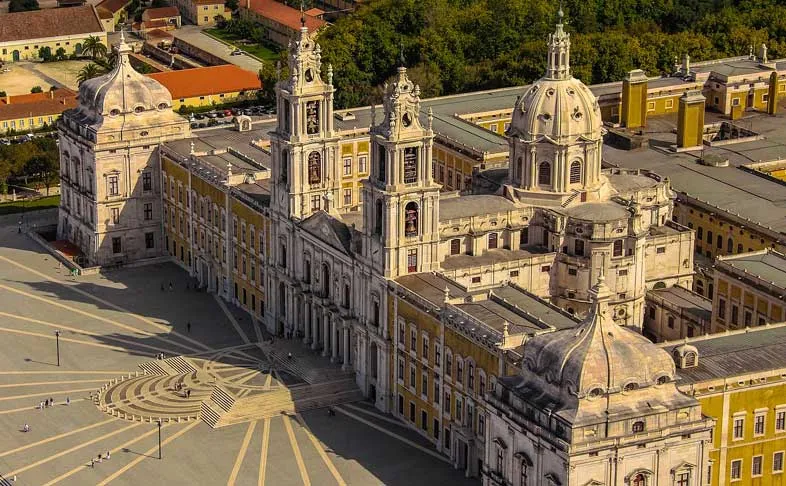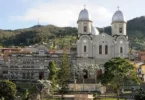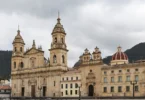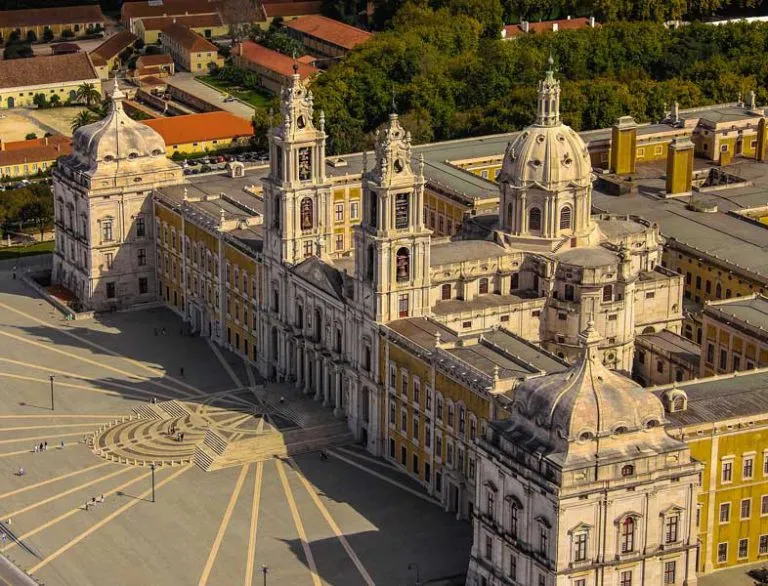
Introduction
The Basilica of Our Lady and Saint Anthony of Mafra is a Roman Catholic shrine and basilica located within the Palace of Mafra, Portugal.
The shrine is dedicated to the Blessed Virgin Mary and Saint Anthony of Padua which once fostered religious devotion among the Portuguese nobility. The Basilica enshrines several Baroque artworks and Christian relics from various European kings collected in Portugal over the centuries. It also serves as the main headquarters the Royal and Venerable Confraternity of the Most Blessed Sacrament of Mafra.
The basilica was designated as a “National Monument” in 1910. Since 7 July 2019, the basilica as part of other surroundings was declared a UNESCO World Heritage Site.
Pope Francis officially granted a decree of Pontifical coronation towards a venerated dolorous image of the Blessed Virgin Mary on 10 November 2020. This announcement was made public on 13 December 2020 with the Mafra carillons playing the Inno e Marcia Pontificale. The rite of coronation is scheduled to be executed on 17 September 2023, simultaneously with the IV Pan-European Forum of Brotherhoods and Confraternities.
History of Basilica of Our Lady and Saint Anthony of Mafra, Lisbon, Portugal
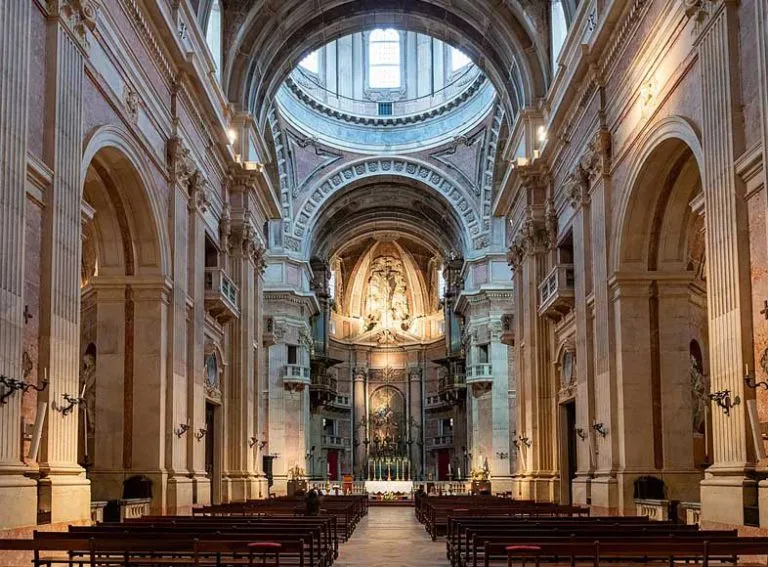
The church is built in the form of a Latin cross with a length of 63 m. It is rather narrow (16.5 m), an impression accentuated by the height of its nave (21.5 m). The vestibule (Galilee porch) contains a group of large sculptures in Carrara marble, representing the patron saints of several monastic orders.
The interior makes abundantly use of local rose-coloured marble, intermingled with white marble in different patterns. The multi-coloured designs of the floor are repeated on the ceiling. The barrel vault rests on fluted Corinthian semicolumns standing between the side chapels.
The chapels in the transept contain altarpieces in jasper made by sculptors from the School of Mafra. The side aisles display 58 marble statues commissioned from the best Roman sculptors of their time. The Most Blessed Sacrament’s chapel in the transept is screened from the crossing by iron railings with bronze ornaments, made in Antwerp.
The choir has a magnificent giant candleholder with seven lamps sprouting from the mouth of seven rolled-up snakes. Above the main altar, inserting into the ceiling, is a gigantic jasper crucifix of 4.2 m, flanked by two kneeling angels, made by the School of Mafra. The cupola over the crossing was also inspired by the cupola of Sant’Agnese in Agone (by the Roman Baroque architect Francesco Borromini). This 70 m-high cupola with a small lantern atop, is carried by four finely sculpted arcs in rose and white marble.
There are six organs, four of which are located in the transept, constituting a rather uncommon ensemble. There were built by Joaquim Peres Fontanes and António Xavier Machado Cerveira between 1792 and 1807 (when the French troops occupied Mafra).
They were made out of partially gilded Brazilian wood. The largest pipe is 6 m high and has a diameter of 0.28 m. King John V had commissioned liturgical vestments from master embroiderers from Genoa and Milan, such as Giuliano Saturni and Benedetto Salandri, and from France. They attest of superb quality and workmanship by their embroidering in gold technique and the use of silk thread in the same colour.
Palace of Mafra
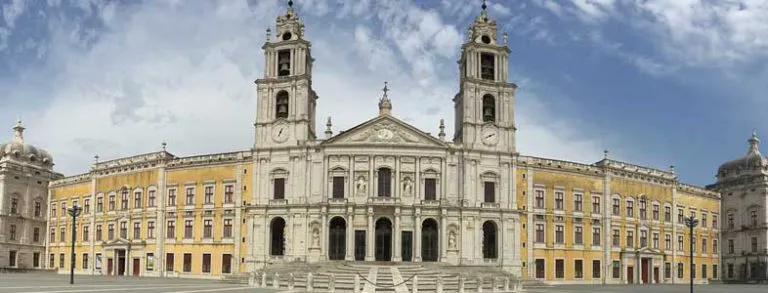
The Palace of Mafra (Portuguese: Palácio de Mafra), also known as the Palace-Convent of Mafra and the Royal Building of Mafra (Real Edifício de Mafra), is a monumental Baroque and Neoclassical palace-monastery located in Mafra, Portugal, some 28 kilometres from Lisbon. Construction began in 1717 under King John V of Portugal and was completely concluded in 1755.
The palace was classified as a National Monument in 1910 and was also a finalist in the Seven Wonders of Portugal. On 7 July 2019, the Royal Building of Mafra – Palace, Basilica, Convent, Cerco Garden and Hunting Park (Tapada) was inscribed as a UNESCO World Heritage Site.
History of Palace of Mafra
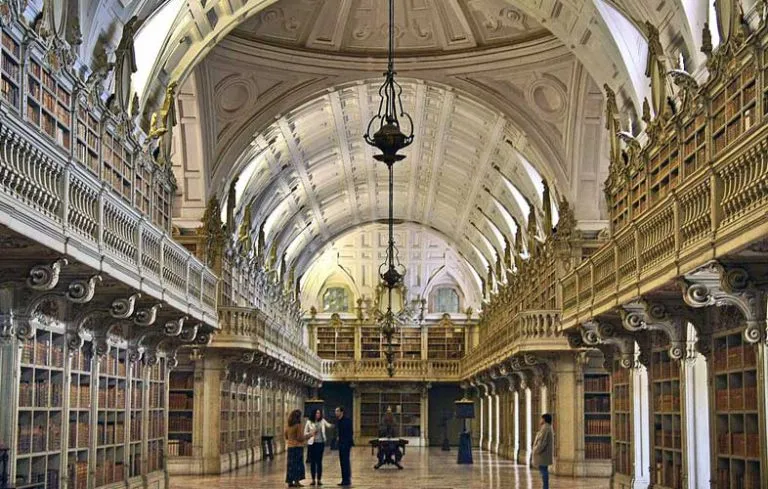
The palace, which also served as a Franciscan friary, was built during the reign of King John V (1717–1750), as consequence of a vow the king made in 1711, to build a convent if his wife, Queen Mariana, gave him offspring. The birth of his first daughter the Infanta Barbara of Portugal, prompted construction of the palace to begin. The palace was conveniently located near royal hunting preserves, and was usually a secondary residence for the royal family.
The construction was funded in large part from the proceeds of the colonies in Brazil, where gold and then diamonds were mined in vast quantities.
This vast complex, largely built of Lioz stone, is among the most sumptuous Baroque buildings in Portugal and at 40,000 m2, one of the largest royal palaces. Designed by the German architect Johann Friedrich Ludwig (João Frederico Ludovice), the palace was built symmetrically from a central axis, occupied by the basilica, and continues lengthwise through the main façade until two major towers.
The structures of the convent are located behind the main façade. The building also includes a major library, with about 30,000 rare books. The basilica is decorated with several Italian statues and includes six historical pipe organs and two carillons, composed of 98 bells.
Construction
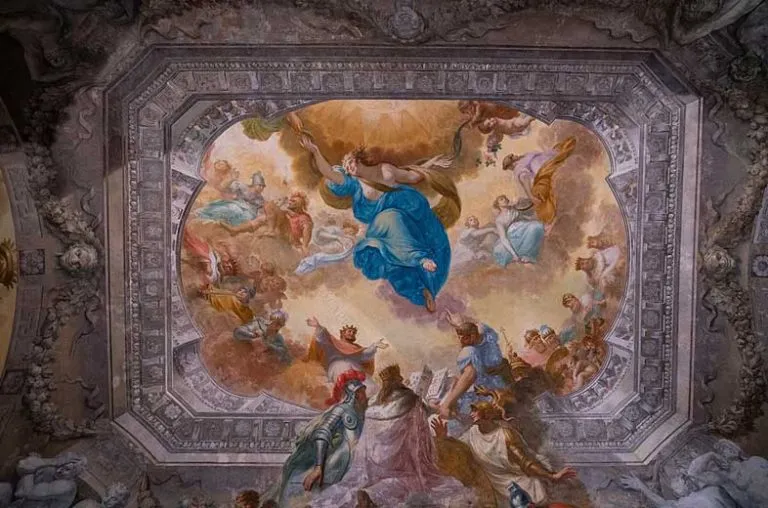
The exact site was chosen in 1713 and purchased in 1716. Construction began by the laying of the first stone on November 17, 1717, with a grand ceremony in the presence of the king, his entire court and the Cardinal Patriarch of Lisbon.
Initially it was a relatively small project for a friary of 13 Capuchin friars, who were to observe strict poverty. However, when the flow of gold and diamonds from the Portuguese colony of Brazil started to arrive in Lisbon in abundance, the king changed his plans and announced the construction of a sumptuous palace along with a much enlarged friary. This immense wealth allowed the king to be a generous patron of the arts.
He appointed an architect João Frederico Ludovice as director of the royal works at Mafra. Ludwig had studied architecture in Rome and knew contemporary Italian art. The extent of Ludwig’s responsibility is unclear, as several other architects were involved in this project: the Milanese builder Carlos Baptista Garbo, Custódio Vieira, Manuel da Maia and even his own son António. However the application of the same architectural style over the whole building suggests the work of Ludwig as the head-architect in charge of the Royal Office of Works (Real Obra).
Construction lasted 13 years and mobilized a vast army of workers from the entire country (a daily average of 15,000 but at the end climbing to 30,000 and a maximum of 45,000), under the command of António Ludovice, the son of the architect. In addition 7,000 soldiers were assigned to preserve order at the construction site. They used 400 kg of gunpowder to blast through the bedrock for the laying of foundations. There was even a hospital for the sick or wounded workers. A total of 1,383 workers died during the construction.
The facade is 220 meters long. The whole complex covers 37,790 m2 with about 1,200 rooms, more than 4,700 doors and windows, and 156 stairways.
When complete the building consisted of a friary capable of sheltering 330 friars, along with a royal palace and a huge library of 30,000 books, embellished with marble, exotic woods and countless artworks taken from France, Flanders and Italy, which included six monumental pipe organs and the two carillons.
The basilica and the convent were inaugurated on the day of the King’s 41st birthday on October 22, 1730. The festivities lasted for 8 days and were of a scale never seen before in Portugal. The basilica was dedicated to Our Lady and to St. Anthony. However the building was not finished. The lantern on the cupola was completed in 1735. Work continued until 1755, when the work force was needed in Lisbon by the devastations of the Lisbon earthquake.
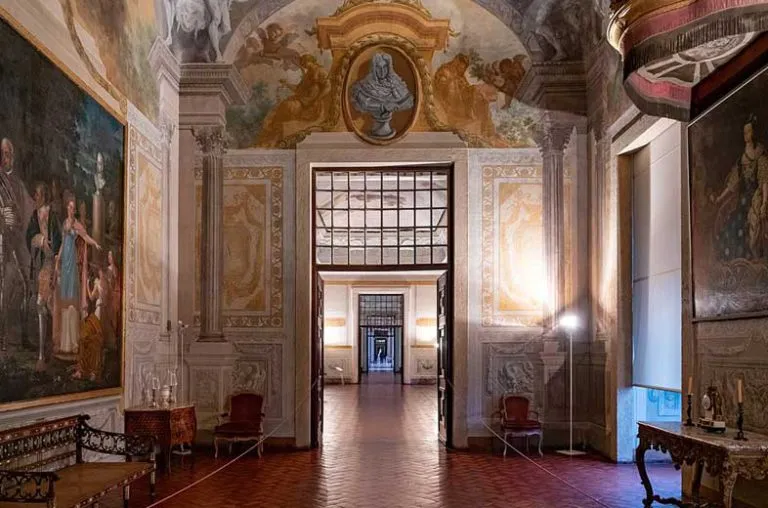
Later History
The palace was not occupied permanently by the royalty, who considered the rooms too gloomy. Nonetheless, it was a popular destination for the members of the royal family who enjoyed hunting in the nearby game preserve, the Tapada Nacional de Mafra. During the reign of King John VI the palace was inhabited for a whole year in 1807.
The king was responsible for a partial renovation of the building by some well-known artists. However, with the French invasion of Portugal, in 1807, the royal family fled to Brazil, taking with them some of the best pieces of art and furniture in the building. Marshal Junot took up residence in the palace, to be driven out in turn by Wellington.
In 1834, after the Liberal Wars, Queen Maria II ordered the dissolution of the religious orders and the convent was abandoned by the Franciscans. During the last reigns of the House of Braganza, the palace was mainly used as a base for hunting. In 1849 the monastery part of the building was assigned to the military, a situation still in use today.
The last king of Portugal, Manuel II, following the proclamation of the republic, left on 5 October 1910 from the palace to the nearby coastal village of Ericeira on his way to exile. The palace was declared a national monument in 1907. At present, the building is conserved by the Portuguese Institute of the Architectonic Patrimony, which carried out several recovery programs, including the conservation of the main façade. A major restoration of the historical pipe organs began in 1998 with the collaboration of foreign experts and was finished in 2010. The restoration won the Europa Nostra 2012 award.
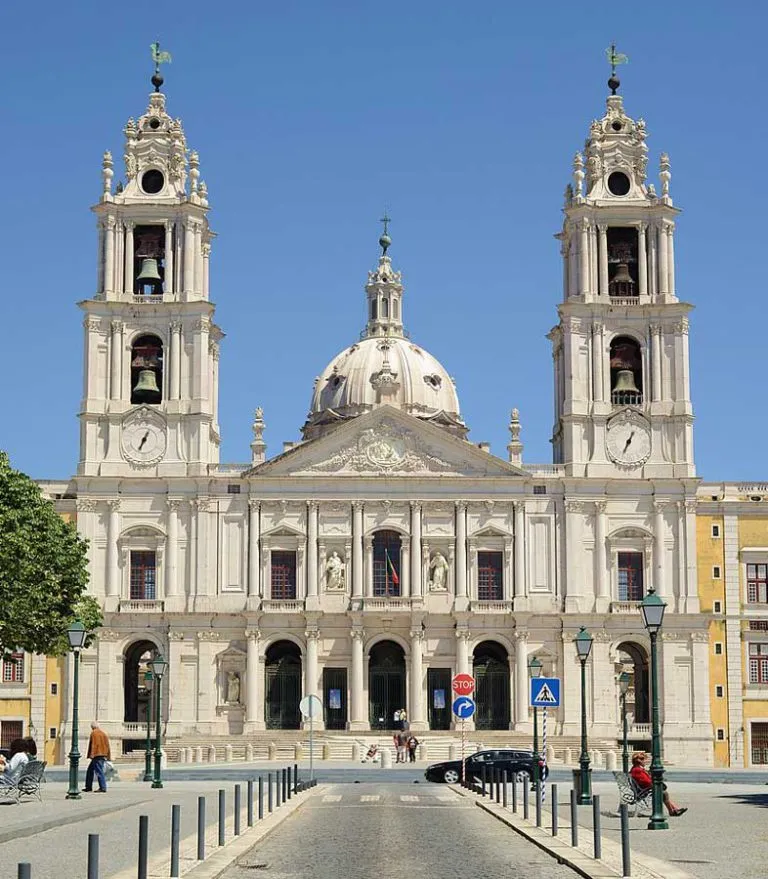
Façade
The imposing façade, built of local limestone, is 220 m long and faces the town of Mafra. At each end of the façade stands a square tower with a bulbous dome, such as found in Central Europe. The church, built in white marble, is located in the centre of the main façade, symmetrically flanked on both sides by the royal palace.
The king, wishing to rival the splendour of Rome, had sought architectural advice from his ambassador to the Vatican, who sent him small-scale models of important Roman religious buildings. The benedictal balcony at its centre is clearly mirrored on the balcony of St. Peter’s Basilica in Rome. But this balcony is rather intended for the king, as a symbol of his power, than for the benedictions by a prelate.
The two church towers (68 m high) are inspired by the towers of Sant’Agnese in Agone (by the Roman Baroque architect Francesco Borromini). Their two carillons contain a total of 92 church bells, founded in Antwerp. The story goes that the Flemish bell-founders were so astonished by the size of their commission, that they asked to be paid in advance. The king retorted by doubling the offered amount. These carillons constitute the largest historical collection in the world.
The two towers are connected by two rows of Corinthian columns. The top row contains the statues of St. Dominic and St. Francis, sculpted from Carrara marble, standing in a niche on each side of the balcony. The lower row contains the statues of St. Clara and St. Elisabeth of Hungary.
Royal Palace
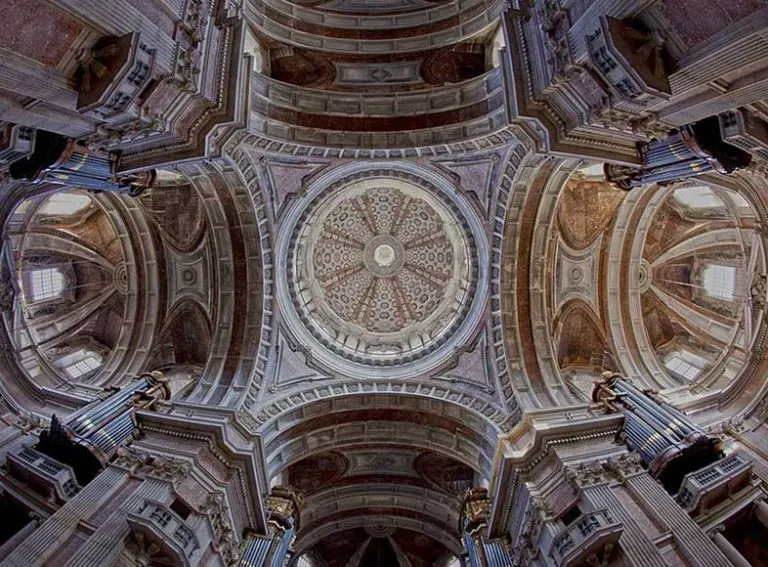
The spacious royal apartments are situated on the second floor. The apartments of the king are situated at the end of the palace while the apartment of the queen is 200 m away at the other end. Such was this distance that, when the king left his apartment towards the apartment of the queen, this was announced to the queen by the sound of a trumpet.
As king John VI had taken with him some of the best pieces of art and furniture in the building when the royal family fled in 1808 for the advancing French troops to Brazil, most rooms had to be redecorated in the original style. The Hunting trophy room (Sala dos Troféus) is decorated with numerous skulls of deer, the furniture is constructed of antlers and covered with deerskin and even the candleholders are made of deer antlers.
The Benediction Gallery (Sala da Benção) borders at the upper level of the basilica. The royal family could here attend Mass, seated at a window opening unto the basilica. The bust of John V in this hall is a work of the Italian Alessandro Giusti. The Throne Room, the Guard Room and the Room of Goddess Diana are decorated with murals by artist such as Ciryllo Wolkmar Machado, Bernardo Oliveira Góis and Vieira Lusitano.
Library
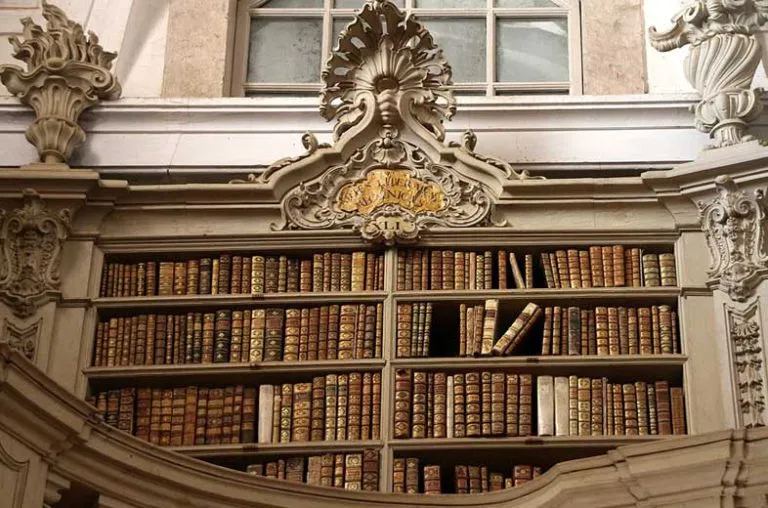
The Rococo library, situated at the back of the second floor, is truly the highlight of this palace, rivalling the grandeur of the library of the Melk Abbey in Austria. Built by Manuel Caetano de Sousa, this library is 88 m long, 9.5 m wide and 13 m high. The magnificent floor is covered with tiles of rose, grey and white marble.
The wooden bookshelves in Rococo style are situated on the sidewalls in two rows, separated by a balcony with a wooden railing. They contain over 36,000 leather-bound volumes, attesting of the extent of western knowledge from the 14th to the 19th century. Among them, are many valuable bibliographical jewels, such as incunabula. These beautiful finished volumes were bound in the local workshop (Livraria) in the rocaille style (also by Manuel Caetano de Sousa).
The library is known for homing bats which protect the books from insect damage. The library was used in Gulliver’s Travels (1996) as the Great Chamber of War for the Emperor of Lilliput.

Mafra School of Sculpture
The Mafra School of Sculpture was founded during the reign of king Joseph I of Portugal, successor of king John V. As the Mafra National Palace had a great need for sculptors, local and from abroad, it became the location of a sculpture academy headed by the Italian Alessandro Giusti (1715–1799).
Among the teachers were several important sculptors, such as José de Almeida (1709–1769), Claude de Laprade (1682–1738) and Giovanni Antonio da Padova (who created most of the statues for the cathedral of Évora).
The academy was awarded many commissions by the Augustinians from the monastery, resulting in the many marble statues and retables in marble and jasper in the basilica. This academy produced several generations of Portuguese sculptors, such as Joaquim Machado de Castro (1731–1822).
Our Lady of Solitude
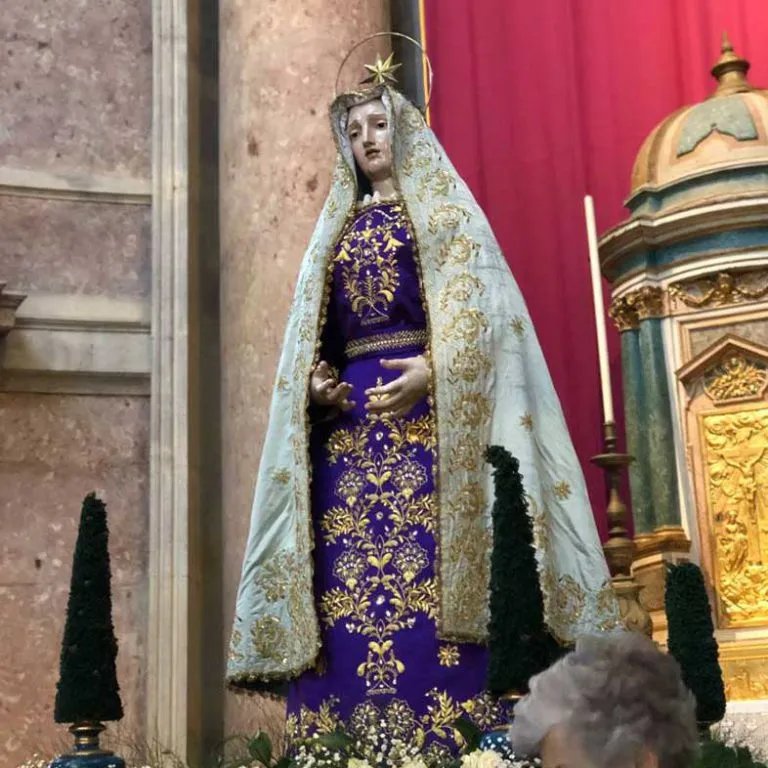
Our Lady of Solitude (Spanish: María de la Soledad; Portuguese: Nossa Senhora da Soledade) is a title of Mary, mother of Jesus and a special form of Marian devotion practised in Spanish-speaking countries to commemorate the solitude of Mary on Holy Saturday. Variant names include Nuestra Señora de la Soledad, Maria Santisima, Nuestra Señora Dolorosisima de la Soledad, and Virgen de la Soledad.
The title originates with Queen Juana lamenting the early death of her husband Philip I of Castile in 1506.
Isabel de Valois, wife of Felipe II, had in a private oratory a painting that she had brought with her from France and that represented the Virgin of the Solitude. The image of the picture aroused great devotion in the friars of the Order of the Minims of San Francisco de Paula, who had settled in Madrid following in the footsteps of the monarch.
The friars asked permission of the queen to have a copy of the image for the chapel of their convent of Our Lady of Victory in Madrid. The image of Our Lady of Solitude was carved by the sculptor Gaspar Becerra.
From the beginning, the image was intended to be “vestidera”, with only the head and hands carved and the rest a wooden frame covered with clothes. It seems that on the initiative of the Countess of Ureña, Dña María de la Cueva y Toledo, the queen’s main waitress, she wore her own outfit of a noble widow of the time; this characteristic attire added to other peculiarities – such as wearing a diadem in place of crown, or be accompanied by the symbols of the Passion – constituted a true revolution in the typology of Marian images.
In 1565, finally, after more than a year of work, the statue of Our Lady of Solitude was presented to the convent of Our Lady of Victory.
History of Our Lady of Solitude
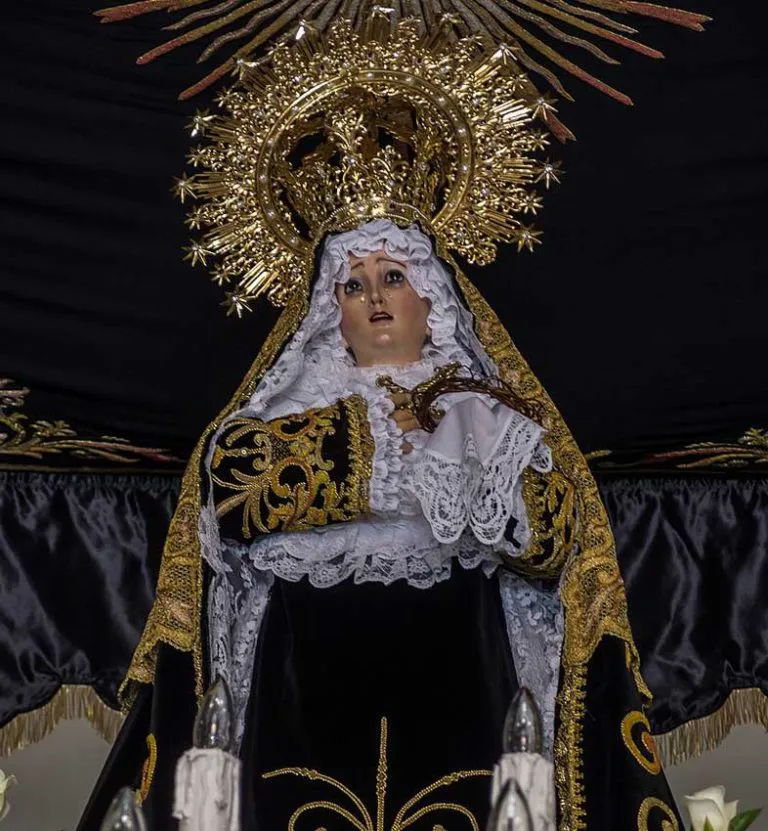
In Spanish-speaking countries special devotion is practiced to Nuestra Señora de la Soledad or Our Lady of Solitude. This devotion was instituted to compassionate Our Lady for her solitude on Holy Saturday and is akin to the devotion practiced among the Servites on Good Friday called the Desolata. The particular statue represented on the front of today’s Novena Notes is in the Sacred Heart Church at the Ayo el Chico, Jalisco, where the Novena has been inaugurated for some time.
Also, a 12/26/55 article from NCWC News Service on Our Lady of Solitude described a different festival commemorating a miraculous image in Oaxaca, Mexico:
Mexico’s traditional devotion to the Mother of God was vividly demonstrated when the citizens of this entire state [Oaxaca, Mexico] paid homage to their patroness, La Virgen de Soledad, or the Virgin of the Lonely, on the Sunday before Christmas. For several nights prior to the Sunday fiesta long, highly impressive religious processions marched to the Church of La Soledad. The scene was enhanced by the colorful paper lanterns, strung on tall poles, carried by the faithful.
The Church of Our Lady of Solitude which dates back to 1692, has an interesting history. Legend has it that a mule driver, guiding his burro train through the streets of Oaxaca, suddenly discovered he had an extra animal, carrying a huge box on his back.
Curious officials opened the box and found within the image of the Blessed Virgin of Solitude. And so, a church was built. Tourists who come to Oaxaca find an enormous boulder at the entrance marking the spot where the burro died from the weight of the box. The patroness of Oaxaca is the special protector of sailors. Thus, in addition to elaborate gowns fashioned by women of the city and a gold and bejeweled crown, the image has shimmering pearls rimming its crown — the gift of seamen.
Also, please note that the first hospital in what is now the USA was built at St Augustine, Florida in 1588 with the name Nostra Senora de la Soledad / Our Lady of Solitude. Finally, note that there is a chapel dedicated to Our Lady of Solitude in Monterey County, California, near the town of Soledad.
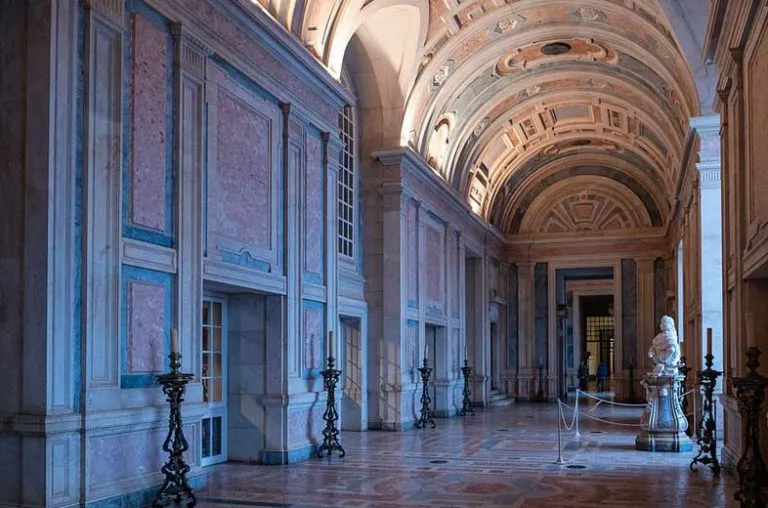
Notable Artwork
The religious paintings in the basilica and the convent constitute one of the most significant 18th century collections in Portugal. They include works by the Italians Agostino Masucci, Corrado Giaquinto, Francesco Trevisani, Pompeo Batoni and some Portuguese students in Rome such as Vieira Lusitano and Inácio de Oliveira Bernardes.
The sculpture collection contains works by almost every major Roman sculptor from the first half of the 18th century. At that time, it represented the biggest single order done by a foreign power in Rome and still is amongst the biggest collections in existence.
Institutions
The catholic parish of Mafra and the Royal and Venerable Confraternity of the Most Blessed Sacrament of Mafra (Portuguese: Real e Venerável Irmandade do Santíssimo Sacramento de Mafra) have their headquarters in the Basilica.
On 10 November 2020, Pope Francis granted a canonical coronation to the image of Our Lady of Solitude of the basilica, guarded by the Confraternity of the Most Blessed Sacrament.
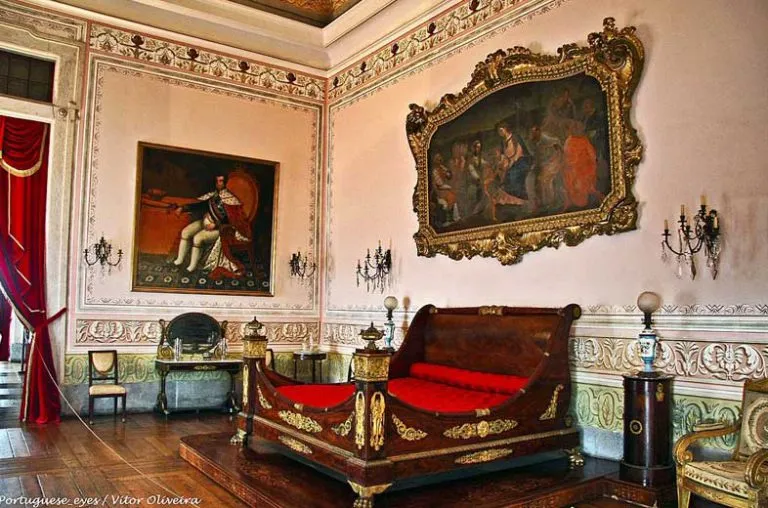
Patroness
María de la Soledad is the patroness of Badajos and Parla, Spain; Porto Covo, Portugal; and Acapulco, Mexico; and of Cavite Province, Philippines, under the name Nuestra Señora de la Soledad de Porta Vaga and in the town of San Isidro, province of Nueva Ecija under the title of Nuestra Señora de la Soledad de San Isidro.
The Mission Nuestra Señora de la Soledad in Soledad, California, is dedicated to Our Lady of Solitude.
Feast Day - 18th December
“This devotion was instituted to compassionate Our Lady for her solitude on Holy Saturday and is akin to the devotion practiced among the Servites on Good Friday called the Desolata.
María de la Soledad’s feast day is celebrated on December 18 in Spanish-speaking countries, on Holy Saturday in English-speaking, and on Good Friday in Portuguese-speaking countries. In Oaxaca, Mexico devotions are held on the Sunday before Christmas.
Mass Time
Weekdays
Sundays
Church Visiting Time
Contact Info
Terreiro D. João V 35,
2640-492 Mafra, Lisbon, Portugal.
Phone No.
Tel : +351 261 817 550
Accommodations
How to reach the Basilica
Lisbon International Airport (LIS) in Lisbon, Portugal is the nearby Airport to the Basilica.
Mafra Train Station in Igreja Nova, Portugal is the nearby Train Station to the Basilica.

